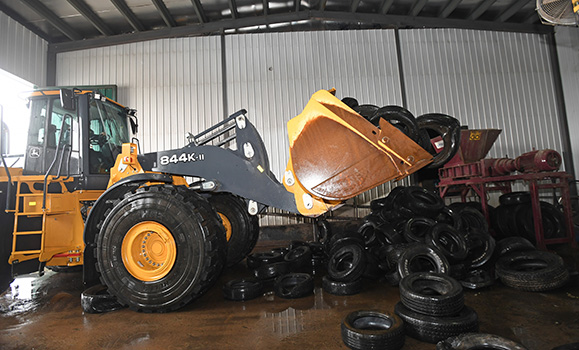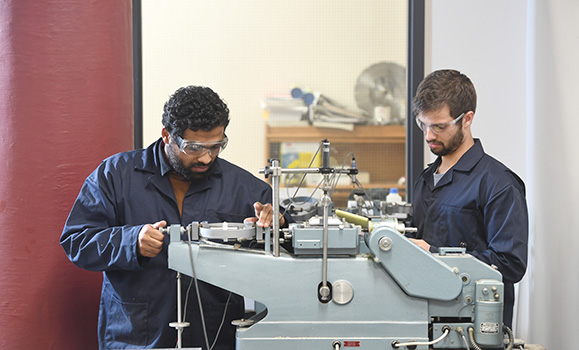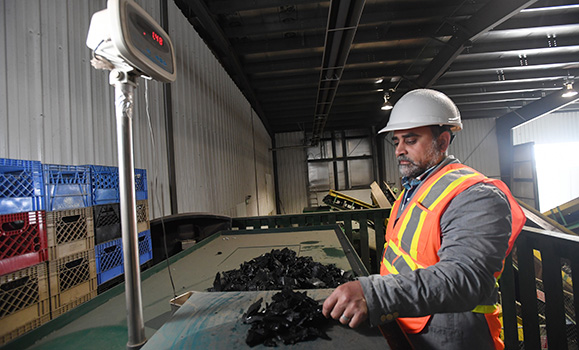Jim Simmons (BEng ‚Äė83, Environmental Engineering) is a big believer in tire derived aggregate (TDA) and the benefits it offers civil engineering projects.
‚ÄúIt‚Äôs an engineered construction material that‚Äôs lightweight, enhances the strength of soil, has great drainage capabilities, is a thermal insulator, and a vibration attenuator,‚ÄĚ says the environmental engineer, who had a 31-year career with Jacques Whitford and Stantec.
‚ÄúAlso, when manufactured to the engineering standard there are no environmental impediments to using this material because, basically, it‚Äôs vulcanized rubber.‚ÄĚ

Handling scrap tires at Halifax C&D Recycling Ltd to be manufactured into Tire Derived Aggregate (TDA).
For the past six years, Simmons has been working with TDA manufacturer Halifax C&D Recycling Ltd. to market the product to civil engineers, private contractors and to the provincial and municipal governments across Nova Scotia. Despite the considerable advantages of TDA over conventional construction materials such as earth fill, demand has been relatively modest to date.
‚ÄúWe used it to build a high-traffic off-ramp for the Ragged Lake bus depot, which saved the Halifax Regional Municipality $140,000,‚ÄĚ says Dan Chassie, president of Halifax C&D Recycling.
‚ÄúWe used it for a drainage system at the Shubenacadie ball field that allows for overnight drainage from flooding that used to take two-to-three weeks. We know it has exceptional engineering qualities and a wide range of applications. We just need to demonstrate that.‚ÄĚ
From research to application
That‚Äôs what Chassie hopes to do through two research projects launched last fall with Hany El Naggar, associate professor and graduate studies coordinator in H¬ĢĽ≠‚Äôs Department of Civil and Resource Engineering. Through a contract with the Natural Sciences and Engineering Research Council of Canada (NSERC), Dr. El Naggar is testing the characteristics of Halifax C&D‚Äôs TDA to establish comprehensive product design guidelines. He is also exploring how TDA can enhance the strength of soil to accommodate major construction projects. Őż

Evaluating standard test results on TDA materials (left to right): Ken Jagoe (operations manager, Halifax C&D Recycling Ltd.), Dr. El Naggar, Mike Chassie (assistant, general manager, Halifax C&D Recycling Ltd.), Jim Simmons.
‚ÄúHistorically, there have been no guidelines for the design of this product, or much documentation on its performance when mixed with soil and used as a foundation,‚ÄĚ says Dr. El Naggar. ‚ÄúIt‚Äôs all been determined on a project-by-project basis. Engineers are reluctant to rely on material that does not have well-established design procedures, so that‚Äôs what our research will create.‚ÄĚ
Őż
Dr. El Naggar is conducting his research with a team of international students: Ahmed Mahgoub, Mohammed Ashari and Yuri Martins. Previously involved with a research project on how TDA could reduce subway train vibrations in his native Iran, Ashari says the results of H¬ĢĽ≠‚Äôs work will have a significant impact on both construction and the environment worldwide.
‚ÄúEvery year, a huge amount of tire scraps are discarded, and they pose the potential for fire and health hazards,‚ÄĚ he says. ‚ÄúBy using these tires in construction, we can turn a potential threat into a valuable asset.‚ÄĚ

Completing shear strength analysis on TDA in the Soils Laboratory at H¬ĢĽ≠ University's Civil Engineering department: students Ahmed Mahboug (left) and Yuri Martins.
It could also be an economic driver for Nova Scotia, as nations around the world look for proven solutions to handle their scrap tires.
‚ÄúThis is about capacity building,‚ÄĚ says Simmons. ‚ÄúIf we do this, and do it well, there‚Äôs no reason our consultants and small businesses can‚Äôt export this knowledge around the world. H¬ĢĽ≠‚Äôs work will make us leaders in this field.‚ÄĚ
New potential
But it is the potential to revolutionize construction in Nova Scotia that excites Dr. El Naggar. ‚ÄúThere are a lot of soft soils here that you cannot readily build on because it is too weak to support infrastructure. But when you use a TDA-soil mixture for the backfill, you have something that is lightweight but significantly reinforces the strength of the foundation soil. Now, you can build the structure you want on that soil, doing it economically without any risk that it will fail.‚ÄĚ
The immediate goal is to publish the results of the characterization testing, which could happen this year, but the long-term goal is to explore the full range of possible applications for TDA ‚ÄĒ everything from bridge foundations to highway embankments over existing utilities and pipelines. Chassie believes that will start to happen once the testing data developed with H¬ĢĽ≠ are published.
‚ÄúI think we‚Äôll see contractors using this material for backfilling retaining walls and government will use it for repairing areas of highways and roadways that continually fail every year,‚ÄĚ says Chassie. ‚ÄúThat‚Äôs when we‚Äôll go from trying to create demand for this product to having to keep pace with it.‚ÄĚ

Dr. El Nassar conducting materials standard sieve analysis testing results on TDA. Őż

